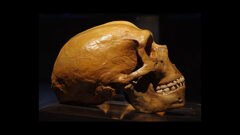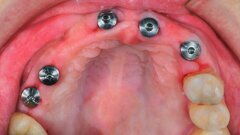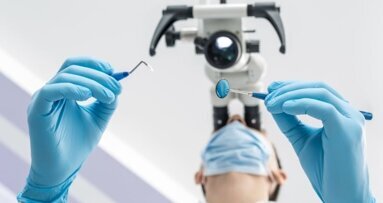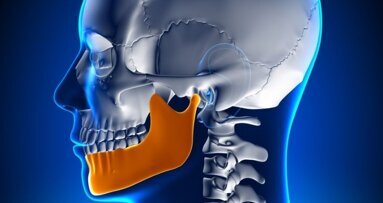Dentistry is a highly evolving profession, integrating technological innovations into diagnostic procedures, streamlining treatments, and digitalising the patient care experience, eventually making the dental clinic a safer place for patients. Irrespective of the technological improvements, the profession is demanding by nature. In pursuit of achieving the perfect smile for patients, the dentist’s physical and mental health takes a back seat. While restoring a patient’s smile is deeply fulfilling, the very act of creating it can take a toll on the dentist’s health.
The slow burn of ergonomic strain
Our bodies experience stress from performing various actions and recover functionally after a brief period. But if put under repetitive stress, performing functions that don't align with proper technique, leaving little room to recover, then it might quickly turn into a chronic ailment, resulting in limited or poor functioning of the body.
Ergonomic injuries are disorders caused or aggravated by the workplace environment. Over time, risk factors such as awkward postures, repetitive strain, and static positions can result in musculoskeletal disorders (MSDs).
Unlike workplace injuries, ergonomic injuries don't show up immediately and may develop into chronic conditions over time. Their growing prevalence makes them a silent epidemic within the profession.
A meta-analysis revealed that musculoskeletal disorders affect approximately 78% of dental professionals, with female dentists 1.4 times more likely to be affected than their male counterparts.[1]
Why does pain become part of the job?
Even with well-designed dental equipment, the need for intense focus and awkward chair positioning makes musculoskeletal strain almost unavoidable.
Dr Bethany Valachi, an internationally recognised dental ergonomics expert and doctor of physical therapy, in an interview with DAME (dentalassistingmadeeasy.com), says that even when dentists and dental assistants maintain ideal posture, more than half of their body muscles remain in sustained contraction.[2]
The profession demands precision, accuracy, and fine motor skills. Dentists spend hours bending forward, sitting in static positions, and focusing intensely on tiny structures within the oral cavity. Over time, these repetitive strains translate into fatigue, back and neck pain, and disorders of the hands and wrists.
The dental instruments are ergonomically designed to provide better grip and control for the dentist while ensuring patient comfort during treatment. Nevertheless, the tight grip on bulky instruments and the pinching movements during handling of small instruments strain the muscles.
The stats will surprise you.
A pilot study at Yenepoya Dental College Hospital, Mangalore, revealed that 73.3% of dentists experienced back stiffness and 23.3% suffered severe back pain. [3]
Musculoskeletal disorders are the world's second leading cause of disability. It is the leading contributor to disability worldwide, with low back pain being the single leading cause of disability in 160 countries. [4]
According to the World Health Organisation, musculoskeletal disorders are a leading cause of disability worldwide, as they have a significant impact on limiting mobility.[4]
The body's warning signs
The commonly encountered ergonomic injuries are head and neck pain, lower back pain, upper back pain, hand and wrist pain, carpal tunnel syndrome, and tendinitis.
Head and neck pain is a common musculoskeletal disorder encountered by dentists. [5] The neck is often the first area to be affected because dentists tend to lean forward or adopt an awkward posture to gain visibility into the patient's mouth. Poor visibility in the working area forces the dentist to lean forward, further worsening neck pain. A workplace that is not ergonomically designed will add to the dentist's misery.
Poor neck posture may radiate to the back, leading to back pain. The continuous faulty movements (leaning, bending, twisting) of the dentist result in an imbalance of the spine and the muscles.
The other prevalent conditions are carpal tunnel syndrome, hand-arm vibration syndrome, and tendinitis. [6] These are attributed to mechanical stress on the hands and palms due to repetitive hand movements and the handling of bulky instruments like forceps during treatments.
MSDs are characterised by throbbing pain in the affected areas, numbness and tingling, reduced grip strength in the hands and fingers, soreness, and stiffness.
The price of precision and perfection
In the process of restoring oral health while reassuring patient comfort, the dentist endures a grind of physical and psychological stress.
Timothy Carusa, a physical therapist with over 30 years of experience, shares his insights on ergonomic injuries among dentists in the Dental Tribune USA newsletter. He shared that chronic pain from the ergonomic injuries could lead to career shortening and disability. Integrating preventive measures, such as basic stretches, into daily practice can help without compromising dentists' health.7
Without proper preventive measures, ergonomic injuries can threaten career longevity and productivity, leading to burnout, reduced motivation, and a decline in both professional and personal well-being.
The pain and discomfort limit the mobility and also participation in society, resulting in isolation from the peer group, which may, in turn, increase the risk of stress, anxiety, and depression.
One of a dentist's main goals is to deliver high-quality treatment to the patient without compromising the patient's comfort. The imbalance between the muscles and the body's movement becomes a hurdle for the dentist in achieving this goal.
Reduced working hours and delayed treatments are not what a dentist dreams of before starting the profession. Burnout and poor professional life will result in low job satisfaction, becoming an economic burden for the dentist due to reduced efficacy and health.
Can you achieve a pain-free practice?
The conventional nature of dentistry, which demands physical exertion and intense focus, predisposes them to ergonomic injuries. Prolonged exposure to risk factors leads to a longer recovery period. While dentistry's demands cannot be eliminated, ergonomic injuries can be prevented with proper strategies and solutions, such as using ergonomically designed tools and equipment and engaging in activities like yoga, strength training, and walking to help maintain musculoskeletal health.
Dr Bethany Valachi, in her website Posturedontics, shares that ergonomic injuries are totally preventable with stretches and targeted exercises. Addressing the root cause is even more critical. The strategies and solutions to prevent ergonomic injuries among dentists will be discussed in detail in the next part.
Healthy dentists, Happy smiles
What and how you perform in the dental chair is going to be a determining factor in your personal and professional life as a dentist. Investing in an ergonomically designed workplace and taking mindful steps, such as short breaks between treatments for basic stretches, can go a long way toward preventing pain and discomfort. For a hopeful, healthy, and productive tomorrow, sow seeds of prevention today.
Addressing ergonomic injuries among dentists is not just about preventing pain and discomfort; it is about ensuring that dentists can continue restoring people's smiles without pain.
References:
1. Chenna D, Pentapati KC, Kumar M, Madi M, Siddiq H. Prevalence of musculoskeletal disorders among dental healthcare providers: A systematic review and meta-analysis. F1000Research. 2022;11:1062. doi:https://doi.org/10.12688/f1000research.124904.2
2. Dental Ergonomics: An Interview with Bethany Valachi. Dentalassistingmadeeasy.com. Published 2025. Accessed October 29, 2025. https://www.dentalassistingmadeeasy.com/blog/dental-orthodontics-interview-bethany-valachi
3. Shaik A, Sripathi Rao B, Husain A, D′sa J. Work-related musculoskeletal disorders among dental surgeons: A pilot study. Contemporary Clinical Dentistry. 2011;2(4):308. doi:https://doi.org/10.4103/0976-237x.91794
World Health Organization. Musculoskeletal health. World Health Organization. Published 2022. https://www.who.int/news-room/fact-sheets/detail/musculoskeletal-conditions
4. Kawtharani AA, Chemeisani A, Salman F, Haj Younes A, Msheik A. Neck and Musculoskeletal Pain Among Dentists: A Review of the Literature. Cureus. Published online January 10, 2023. doi:https://doi.org/10.7759/cureus.33609
5. Gupta G, Bhat M, Gupta A, Mohammed T, Bansal N. Ergonomics in Dentistry. International Journal of Clinical Pediatric Dentistry. 2014;7(1):30-34. doi:https://doi.org/10.5005/jp-journals-10005-1229
6. Iveta Ramonaite, Dental Tribune International. Back and neck pain in dentistry: A new reality. Dental Tribune International. Published February 21, 2024. https://www.dental-tribune.com/news/back-and-neck-pain-in-dentistry-a-new-reality/
Topics:
Tags:
Dentists work hard to create perfect smiles for their patients. But are they also taking care of their smiles? Dentistry can be a rewarding career, but it ...
Today magnification has revolutionized dentistry all around the world. Higher magnification with a dental operating microscope (DOM) is clearly an asset, ...
State of the art dentistry is all about providing atraumatic and minimally invasive dental treatments to the patients, while improving the clinician's ...
The second part of the series gives simple guidelines to beginners on how to choose a magnification system.
Dr. Maria Csillag is the inventor, chief instructor, and owner of Smylist® Ltd. Dr. Maria’s key achievements include the development of the Smylist® ...
A study was carried out to evaluate the co-relation between mandibular rotations in patients with a history of mid back pain, lower back pain, and knee ...
Live webinar
Mon. 12 January 2026
7:30 pm IST (New Delhi)
Prof. Judith Jones D.D.S; M.P.H., Prof. Kakuhiro Fukai D.D.S., Ph.D, Dr. Bathsheba (Bethy) Turton
Live webinar
Wed. 14 January 2026
10:30 pm IST (New Delhi)
Dr. Théo Laplane, Dr. Robert Gottlander DDS
Live webinar
Fri. 16 January 2026
10:30 pm IST (New Delhi)
Live webinar
Mon. 19 January 2026
11:30 pm IST (New Delhi)
Philipp Kopp, Michael Seeber
Live webinar
Fri. 23 January 2026
12:30 am IST (New Delhi)
Dr. Nicola M. Grande DDS, PhD
Live webinar
Wed. 28 January 2026
6:30 pm IST (New Delhi)
Live webinar
Wed. 28 January 2026
9:30 pm IST (New Delhi)
Prof. Dr. Jan-Frederik Güth



 Austria / Österreich
Austria / Österreich
 Bosnia and Herzegovina / Босна и Херцеговина
Bosnia and Herzegovina / Босна и Херцеговина
 Bulgaria / България
Bulgaria / България
 Croatia / Hrvatska
Croatia / Hrvatska
 Czech Republic & Slovakia / Česká republika & Slovensko
Czech Republic & Slovakia / Česká republika & Slovensko
 France / France
France / France
 Germany / Deutschland
Germany / Deutschland
 Greece / ΕΛΛΑΔΑ
Greece / ΕΛΛΑΔΑ
 Hungary / Hungary
Hungary / Hungary
 Italy / Italia
Italy / Italia
 Netherlands / Nederland
Netherlands / Nederland
 Nordic / Nordic
Nordic / Nordic
 Poland / Polska
Poland / Polska
 Portugal / Portugal
Portugal / Portugal
 Romania & Moldova / România & Moldova
Romania & Moldova / România & Moldova
 Slovenia / Slovenija
Slovenia / Slovenija
 Serbia & Montenegro / Србија и Црна Гора
Serbia & Montenegro / Србија и Црна Гора
 Spain / España
Spain / España
 Switzerland / Schweiz
Switzerland / Schweiz
 Turkey / Türkiye
Turkey / Türkiye
 UK & Ireland / UK & Ireland
UK & Ireland / UK & Ireland
 International / International
International / International
 Brazil / Brasil
Brazil / Brasil
 Canada / Canada
Canada / Canada
 Latin America / Latinoamérica
Latin America / Latinoamérica
 USA / USA
USA / USA
 China / 中国
China / 中国
 Pakistan / Pākistān
Pakistan / Pākistān
 Vietnam / Việt Nam
Vietnam / Việt Nam
 ASEAN / ASEAN
ASEAN / ASEAN
 Israel / מְדִינַת יִשְׂרָאֵל
Israel / מְדִינַת יִשְׂרָאֵל
 Algeria, Morocco & Tunisia / الجزائر والمغرب وتونس
Algeria, Morocco & Tunisia / الجزائر والمغرب وتونس
 Middle East / Middle East
Middle East / Middle East
























































To post a reply please login or register